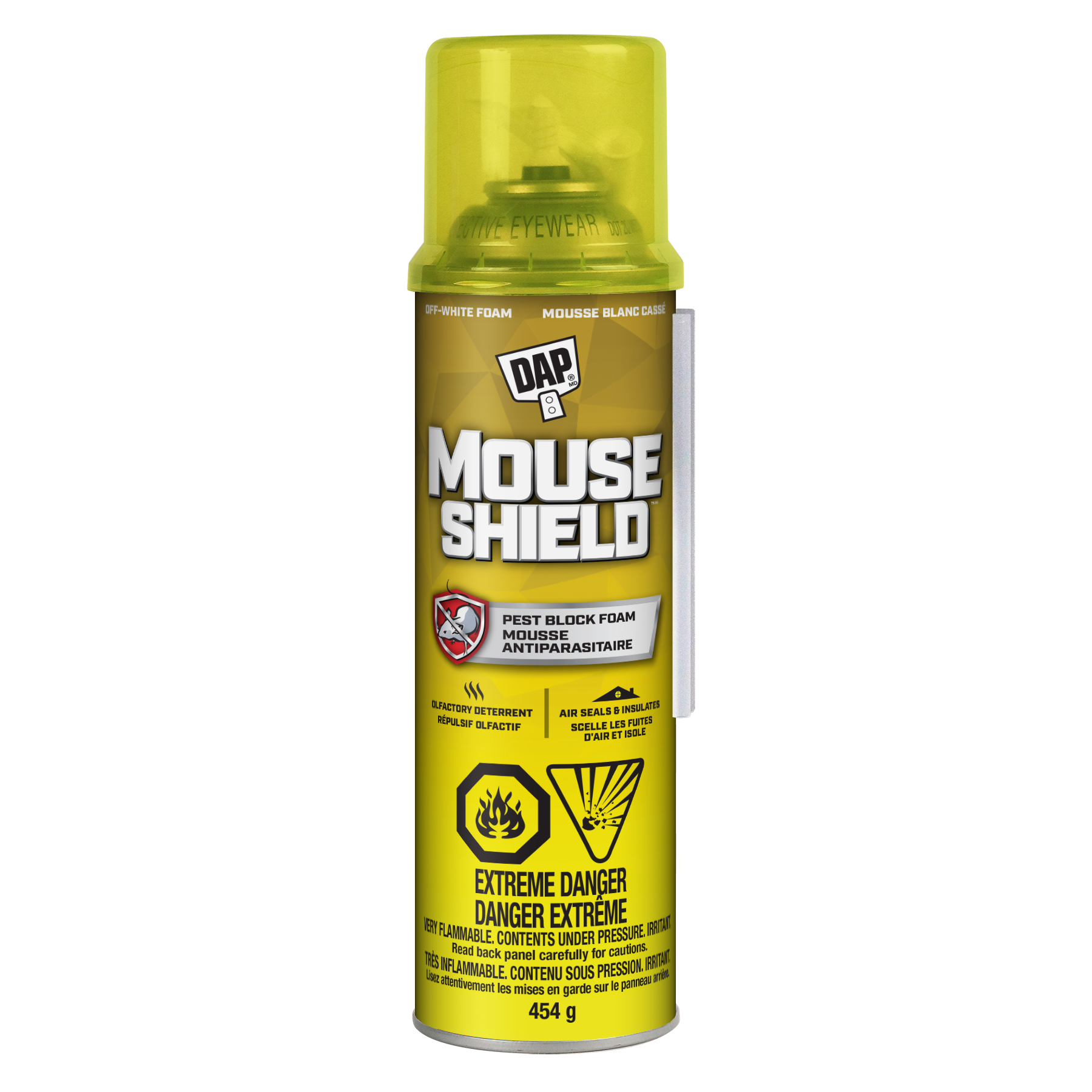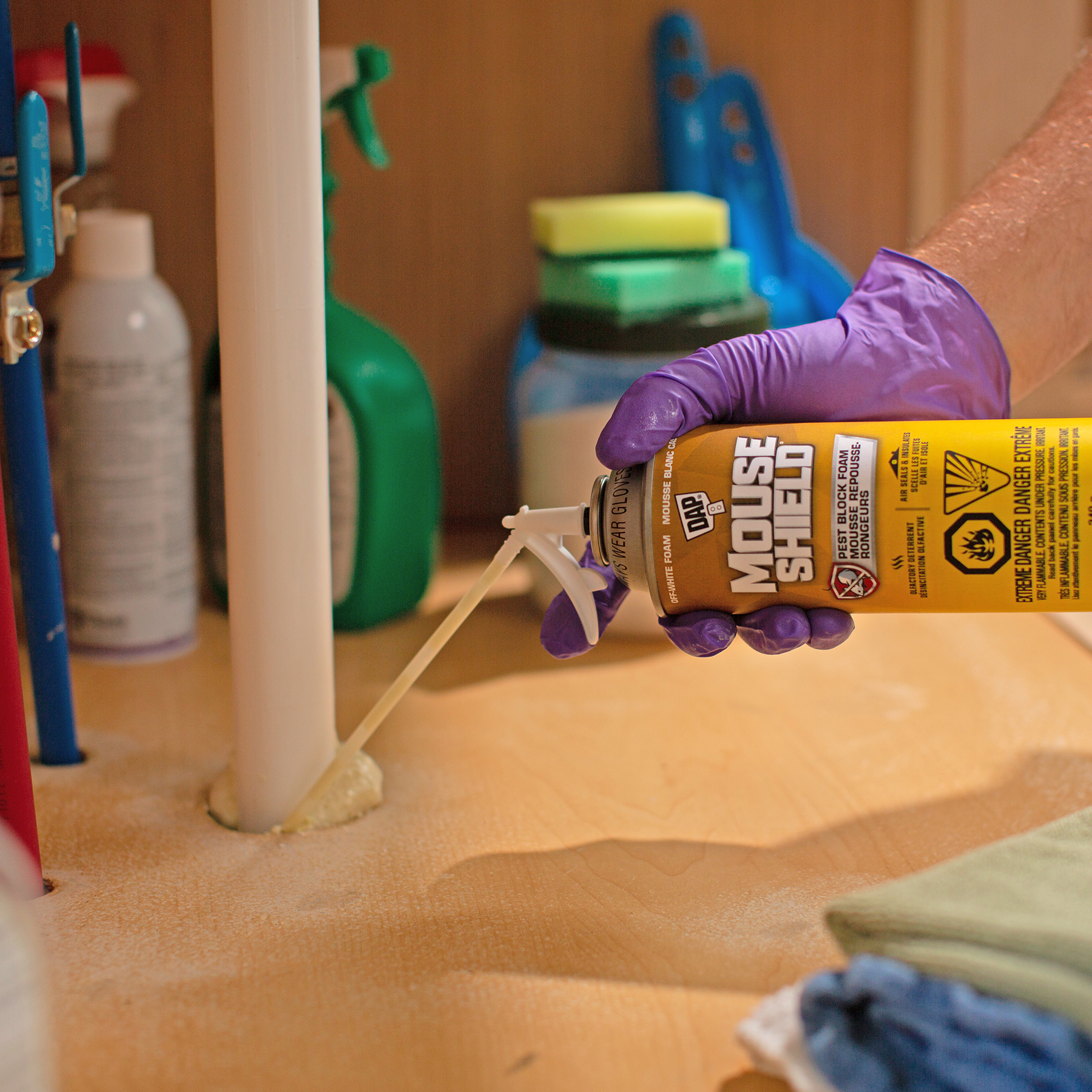Mouse Shield® Foam Sealant & Blocker
Specially formulated to block mice, birds, bats, tree squirrels and other pests such as ants, roaches, spiders and bees. Use to fill gaps and cracks inside your garage, attic, crawl space, basement, under sinks, around pipe/electrical penetrations or any areas where pests, insects or drafts can enter your home and living spaces.
Key Features
-
 Air Seals
Air Seals -
 Reusable Adapter + Bonus Straw
Reusable Adapter + Bonus Straw -
 Class 1 Fire Rated
Class 1 Fire Rated
DETAILS + SPECIFICATIONS
- Details
-
Specifications
SKU Code Unit Size Color Dimensions (in.) Weight Case Pack Cases/Pallet 7565012507 12507 340 G OFF WHITE 8.75x6x8.13 6.06 lbs. 6 216 7565041612 41612 454 G OFF WHITE 11.5x9x10.63 16.45 lbs. 12 90
RESOURCES + FAQs
- Technical Data
- How To's/Tips
-
FAQs
How can I remove foam from skin?
If the foam has not cured (it is still moist), it may be removed by wiping off with a dry cloth. Do not use soap and water as moisture helps to cure foam. Use a thick layer of petroleum jelly or Vaseline over the areas that are affected, then wrap your hands in plastic. This could be plastic wrap from the kitchen, plastic dishwashing gloves, or even a shopping bag. Wait for 1 hour. During that time, the skin will release natural oils from under the foam, the Vaseline will be on top of the foam, and the plastic bag will hold body heat close. All together, this will begin to soften the foam enough to remove it carefully from the skin. If necessary, repeat the process. Once the majority of foam has been removed, use a pumice stone or workman’s soap with pumice to gently remove the remaining residue from the skin. Anything remaining will wear off within a few days. No solvent will remove cured (dry) foam. Cured foam is not harmful to health.
How does foam sealant compare to other types of insulation?
Unlike caulking materials and other sealants that are solid, heavy and non-insulating, foam sealants expand to form an outer skin that contains closed air cells that provide an effective barrier against energy loss. Touch ‘n Foam Professional forms a permanent seal that will not shrink or pull away from the material it has bonded to, making foam the best sealant available against air and moisture infiltration.
Is Touch 'n Foam fire retardant?
Yes. Touch 'n Foam sealants meet the criteria of flame / smoke spread to be classified as a Class A foam. While these sealants are fire retardant (self-extinguishing when flame is removed), they are not intended to be used a fire barrier or fire stop.
Is Touch 'n Foam waterproof?
Touch 'n Foam insulating sealants are water-resistant and form an airtight seal when applied properly.
Can Touch 'n Foam be used to insulate a wall?
No. Touch 'n Foam insulating sealants are formulated to fill cracks, gaps and small voids and require ventilation and humidity to cure. Larger voids may not allow enough air penetration for proper curing and may require special techniques to insulate properly. Touch 'n Foam products should not be used around tub surrounds.
Where should Touch 'n Foam be used?
Touch 'n Foam makes a full line of insulating sealants that can be used all around the home to stop air leakage and drafts. Use around windows and doors, plumbing fixtures, electrical outlets (around, not inside, junction boxes), baseboards, sill plates, exhaust vents, siding edges, sky lights, attic fans, garage ceilings, etc. Review our Uses for Foam and Energy Saving Tips pages for more ideas.
Can Touch 'n Foam be used outdoors?
We recommend Touch ‘n Foam Landscape foam for exterior applications. Landscape will not discolor or break down in sunlight like other foams. It is plant and fish safe, and the dark color blends into shadows well. Touch 'n Foam MaxFilland Home Seal formulas may also be used indoors or outdoors. These foams should be painted when used outside in order to prevent discoloration and break down from UV exposure. Foam can be painted in about one hour after dispensing. Touch 'n Foam No Warp, Fire Break and Easy Fill should be used indoors only.
Will Touch 'n Foam prevent insects or rodents from penetrating into the home?
Touch 'n Foam insulating sealants do not contain any nutritive value and provide an effective barrier against insect and pest intrusion; however, some persistent pests may chew through cured foam. Touch 'n Foam recently launched Mouse Shield Foam Sealant + Blocker as a specialty foam containing an EPA-registered pesticide that protects the foam from attack by mice, birds, bats and tree squirrels. It also blocks ants, roaches, spiders and bees.
How do I store Touch 'n Foam?
Store can upright below 90°F. It’s important to keep the can upright to ensure air doesn’t leak from the valve until ready to use. Never store Touch ‘n Foam in your vehicle.
Can I reuse DAP Foam?
DAP Foam is reusable for up to three weeks after initial use. To store unused portion, bend straw back and attach to the knob atop the dispensing trigger. Store can upright below 90°F. Reuse product within three weeks. To re-use, cut the end off the straw (removing any cured foam), shake well and apply as directed.
Can foam be trimmed or painted?
Yes, after allowing the foam to cure. Foam can be trimmed, sanded or painted about one hour after application.
Do surfaces require any special preparation before applying DAP Foam?
Application surface must be clean, dry and free of all foreign material.

 Canada - EN
Canada - EN USA - EN
USA - EN





